2004 CHRYSLER VOYAGER heater
[x] Cancel search: heaterPage 2518 of 2585
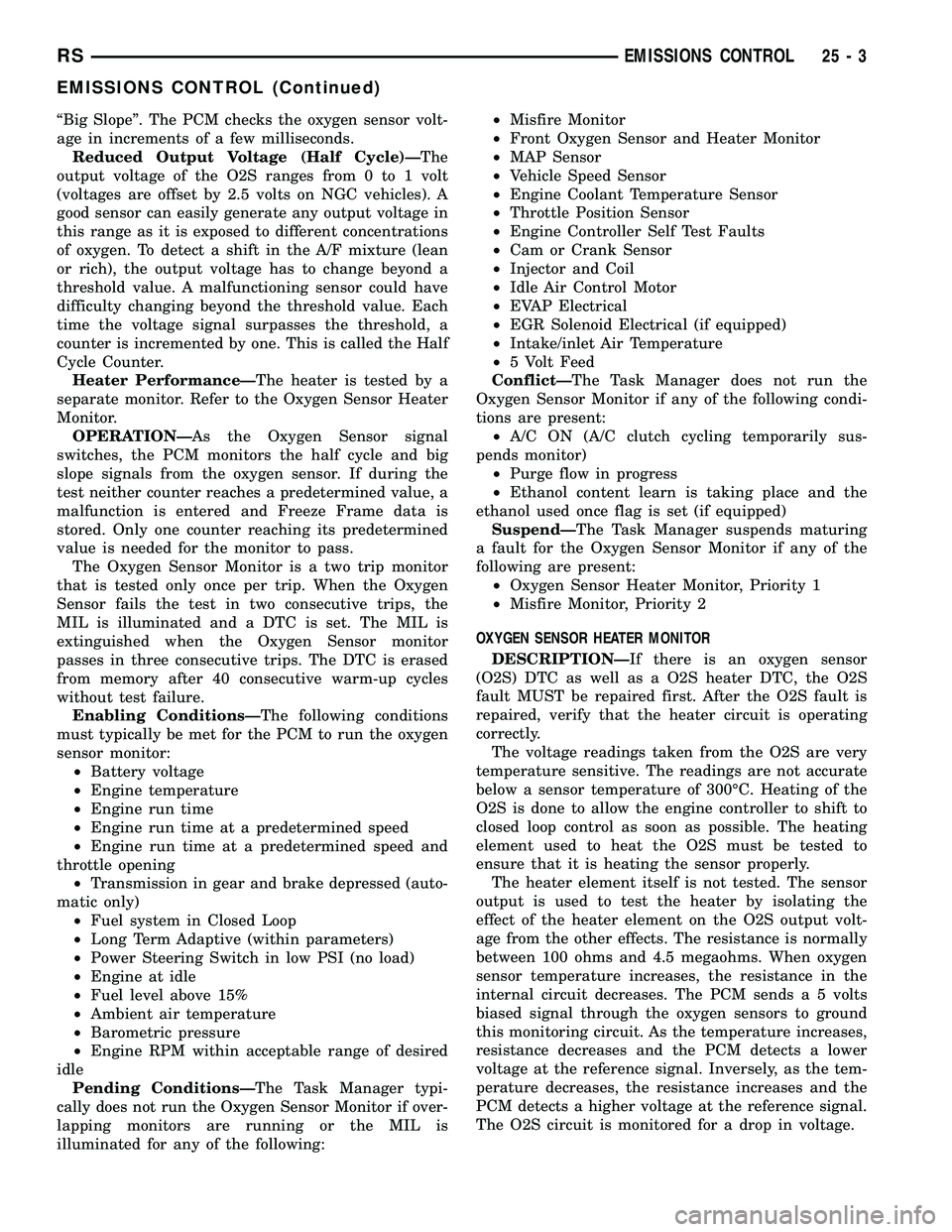
ªBig Slopeº. The PCM checks the oxygen sensor volt-
age in increments of a few milliseconds.
Reduced Output Voltage (Half Cycle)ÐThe
output voltage of the O2S ranges from 0 to 1 volt
(voltages are offset by 2.5 volts on NGC vehicles). A
good sensor can easily generate any output voltage in
this range as it is exposed to different concentrations
of oxygen. To detect a shift in the A/F mixture (lean
or rich), the output voltage has to change beyond a
threshold value. A malfunctioning sensor could have
difficulty changing beyond the threshold value. Each
time the voltage signal surpasses the threshold, a
counter is incremented by one. This is called the Half
Cycle Counter.
Heater PerformanceÐThe heater is tested by a
separate monitor. Refer to the Oxygen Sensor Heater
Monitor.
OPERATIONÐAs the Oxygen Sensor signal
switches, the PCM monitors the half cycle and big
slope signals from the oxygen sensor. If during the
test neither counter reaches a predetermined value, a
malfunction is entered and Freeze Frame data is
stored. Only one counter reaching its predetermined
value is needed for the monitor to pass.
The Oxygen Sensor Monitor is a two trip monitor
that is tested only once per trip. When the Oxygen
Sensor fails the test in two consecutive trips, the
MIL is illuminated and a DTC is set. The MIL is
extinguished when the Oxygen Sensor monitor
passes in three consecutive trips. The DTC is erased
from memory after 40 consecutive warm-up cycles
without test failure.
Enabling ConditionsÐThe following conditions
must typically be met for the PCM to run the oxygen
sensor monitor:
²Battery voltage
²Engine temperature
²Engine run time
²Engine run time at a predetermined speed
²Engine run time at a predetermined speed and
throttle opening
²Transmission in gear and brake depressed (auto-
matic only)
²Fuel system in Closed Loop
²Long Term Adaptive (within parameters)
²Power Steering Switch in low PSI (no load)
²Engine at idle
²Fuel level above 15%
²Ambient air temperature
²Barometric pressure
²Engine RPM within acceptable range of desired
idle
Pending ConditionsÐThe Task Manager typi-
cally does not run the Oxygen Sensor Monitor if over-
lapping monitors are running or the MIL is
illuminated for any of the following:²Misfire Monitor
²Front Oxygen Sensor and Heater Monitor
²MAP Sensor
²Vehicle Speed Sensor
²Engine Coolant Temperature Sensor
²Throttle Position Sensor
²Engine Controller Self Test Faults
²Cam or Crank Sensor
²Injector and Coil
²Idle Air Control Motor
²EVAP Electrical
²EGR Solenoid Electrical (if equipped)
²Intake/inlet Air Temperature
²5 Volt Feed
ConflictÐThe Task Manager does not run the
Oxygen Sensor Monitor if any of the following condi-
tions are present:
²A/C ON (A/C clutch cycling temporarily sus-
pends monitor)
²Purge flow in progress
²Ethanol content learn is taking place and the
ethanol used once flag is set (if equipped)
SuspendÐThe Task Manager suspends maturing
a fault for the Oxygen Sensor Monitor if any of the
following are present:
²Oxygen Sensor Heater Monitor, Priority 1
²Misfire Monitor, Priority 2
OXYGEN SENSOR HEATER MONITOR
DESCRIPTIONÐIf there is an oxygen sensor
(O2S) DTC as well as a O2S heater DTC, the O2S
fault MUST be repaired first. After the O2S fault is
repaired, verify that the heater circuit is operating
correctly.
The voltage readings taken from the O2S are very
temperature sensitive. The readings are not accurate
below a sensor temperature of 300ÉC. Heating of the
O2S is done to allow the engine controller to shift to
closed loop control as soon as possible. The heating
element used to heat the O2S must be tested to
ensure that it is heating the sensor properly.
The heater element itself is not tested. The sensor
output is used to test the heater by isolating the
effect of the heater element on the O2S output volt-
age from the other effects. The resistance is normally
between 100 ohms and 4.5 megaohms. When oxygen
sensor temperature increases, the resistance in the
internal circuit decreases. The PCM sends a 5 volts
biased signal through the oxygen sensors to ground
this monitoring circuit. As the temperature increases,
resistance decreases and the PCM detects a lower
voltage at the reference signal. Inversely, as the tem-
perature decreases, the resistance increases and the
PCM detects a higher voltage at the reference signal.
The O2S circuit is monitored for a drop in voltage.
RSEMISSIONS CONTROL25-3
EMISSIONS CONTROL (Continued)
Page 2519 of 2585
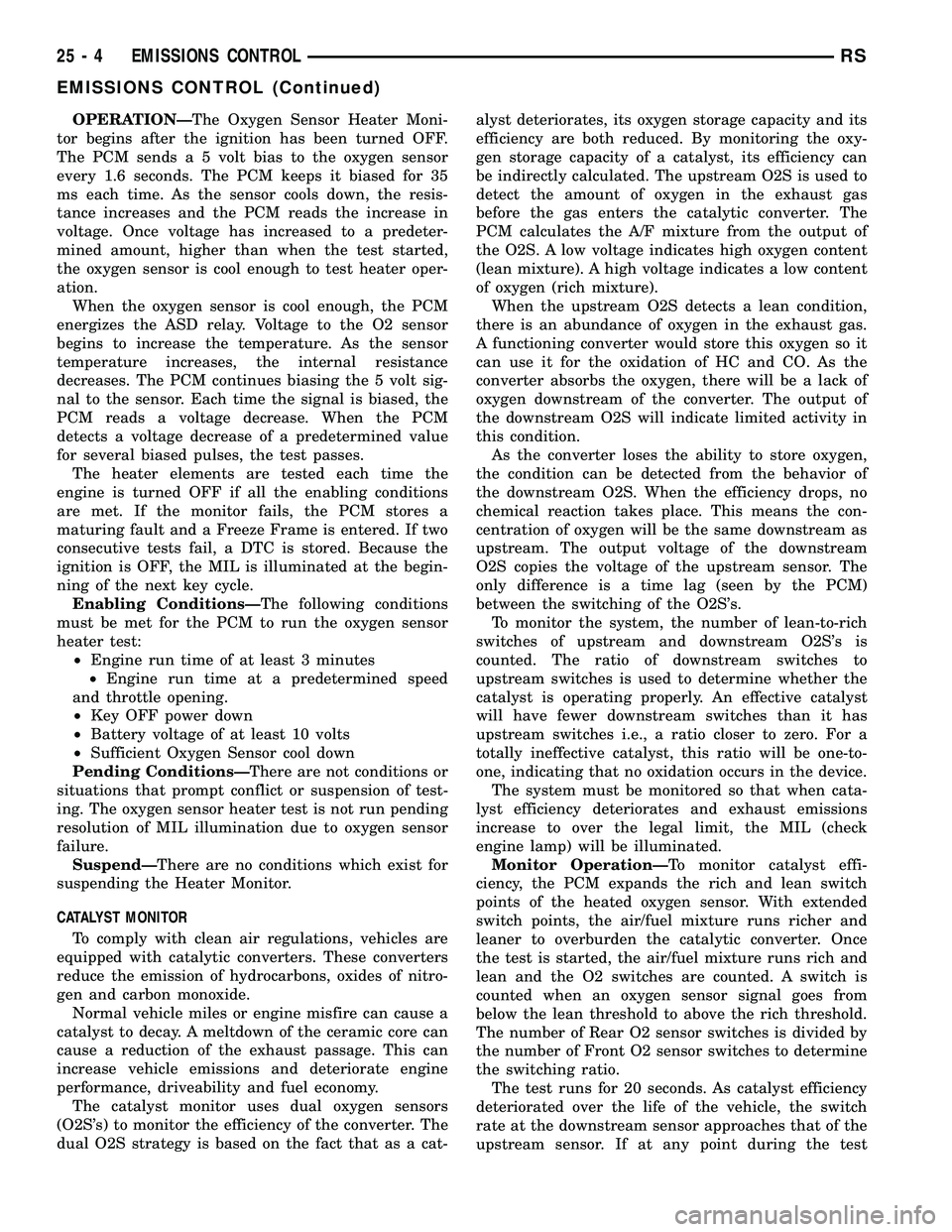
OPERATIONÐThe Oxygen Sensor Heater Moni-
tor begins after the ignition has been turned OFF.
The PCM sends a 5 volt bias to the oxygen sensor
every 1.6 seconds. The PCM keeps it biased for 35
ms each time. As the sensor cools down, the resis-
tance increases and the PCM reads the increase in
voltage. Once voltage has increased to a predeter-
mined amount, higher than when the test started,
the oxygen sensor is cool enough to test heater oper-
ation.
When the oxygen sensor is cool enough, the PCM
energizes the ASD relay. Voltage to the O2 sensor
begins to increase the temperature. As the sensor
temperature increases, the internal resistance
decreases. The PCM continues biasing the 5 volt sig-
nal to the sensor. Each time the signal is biased, the
PCM reads a voltage decrease. When the PCM
detects a voltage decrease of a predetermined value
for several biased pulses, the test passes.
The heater elements are tested each time the
engine is turned OFF if all the enabling conditions
are met. If the monitor fails, the PCM stores a
maturing fault and a Freeze Frame is entered. If two
consecutive tests fail, a DTC is stored. Because the
ignition is OFF, the MIL is illuminated at the begin-
ning of the next key cycle.
Enabling ConditionsÐThe following conditions
must be met for the PCM to run the oxygen sensor
heater test:
²Engine run time of at least 3 minutes
²Engine run time at a predetermined speed
and throttle opening.
²Key OFF power down
²Battery voltage of at least 10 volts
²Sufficient Oxygen Sensor cool down
Pending ConditionsÐThere are not conditions or
situations that prompt conflict or suspension of test-
ing. The oxygen sensor heater test is not run pending
resolution of MIL illumination due to oxygen sensor
failure.
SuspendÐThere are no conditions which exist for
suspending the Heater Monitor.
CATALYST MONITOR
To comply with clean air regulations, vehicles are
equipped with catalytic converters. These converters
reduce the emission of hydrocarbons, oxides of nitro-
gen and carbon monoxide.
Normal vehicle miles or engine misfire can cause a
catalyst to decay. A meltdown of the ceramic core can
cause a reduction of the exhaust passage. This can
increase vehicle emissions and deteriorate engine
performance, driveability and fuel economy.
The catalyst monitor uses dual oxygen sensors
(O2S's) to monitor the efficiency of the converter. The
dual O2S strategy is based on the fact that as a cat-alyst deteriorates, its oxygen storage capacity and its
efficiency are both reduced. By monitoring the oxy-
gen storage capacity of a catalyst, its efficiency can
be indirectly calculated. The upstream O2S is used to
detect the amount of oxygen in the exhaust gas
before the gas enters the catalytic converter. The
PCM calculates the A/F mixture from the output of
the O2S. A low voltage indicates high oxygen content
(lean mixture). A high voltage indicates a low content
of oxygen (rich mixture).
When the upstream O2S detects a lean condition,
there is an abundance of oxygen in the exhaust gas.
A functioning converter would store this oxygen so it
can use it for the oxidation of HC and CO. As the
converter absorbs the oxygen, there will be a lack of
oxygen downstream of the converter. The output of
the downstream O2S will indicate limited activity in
this condition.
As the converter loses the ability to store oxygen,
the condition can be detected from the behavior of
the downstream O2S. When the efficiency drops, no
chemical reaction takes place. This means the con-
centration of oxygen will be the same downstream as
upstream. The output voltage of the downstream
O2S copies the voltage of the upstream sensor. The
only difference is a time lag (seen by the PCM)
between the switching of the O2S's.
To monitor the system, the number of lean-to-rich
switches of upstream and downstream O2S's is
counted. The ratio of downstream switches to
upstream switches is used to determine whether the
catalyst is operating properly. An effective catalyst
will have fewer downstream switches than it has
upstream switches i.e., a ratio closer to zero. For a
totally ineffective catalyst, this ratio will be one-to-
one, indicating that no oxidation occurs in the device.
The system must be monitored so that when cata-
lyst efficiency deteriorates and exhaust emissions
increase to over the legal limit, the MIL (check
engine lamp) will be illuminated.
Monitor OperationÐTo monitor catalyst effi-
ciency, the PCM expands the rich and lean switch
points of the heated oxygen sensor. With extended
switch points, the air/fuel mixture runs richer and
leaner to overburden the catalytic converter. Once
the test is started, the air/fuel mixture runs rich and
lean and the O2 switches are counted. A switch is
counted when an oxygen sensor signal goes from
below the lean threshold to above the rich threshold.
The number of Rear O2 sensor switches is divided by
the number of Front O2 sensor switches to determine
the switching ratio.
The test runs for 20 seconds. As catalyst efficiency
deteriorated over the life of the vehicle, the switch
rate at the downstream sensor approaches that of the
upstream sensor. If at any point during the test
25 - 4 EMISSIONS CONTROLRS
EMISSIONS CONTROL (Continued)
Page 2520 of 2585
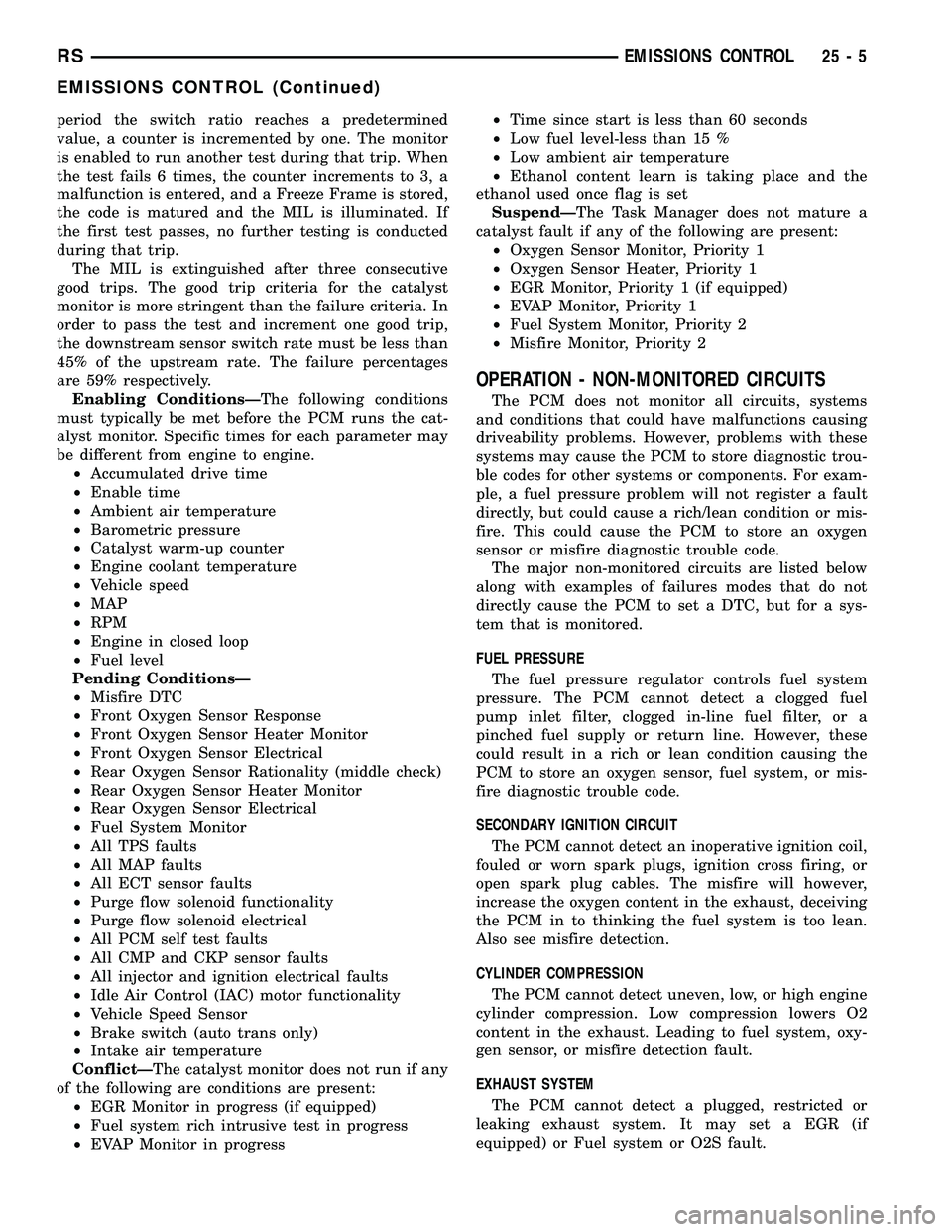
period the switch ratio reaches a predetermined
value, a counter is incremented by one. The monitor
is enabled to run another test during that trip. When
the test fails 6 times, the counter increments to 3, a
malfunction is entered, and a Freeze Frame is stored,
the code is matured and the MIL is illuminated. If
the first test passes, no further testing is conducted
during that trip.
The MIL is extinguished after three consecutive
good trips. The good trip criteria for the catalyst
monitor is more stringent than the failure criteria. In
order to pass the test and increment one good trip,
the downstream sensor switch rate must be less than
45% of the upstream rate. The failure percentages
are 59% respectively.
Enabling ConditionsÐThe following conditions
must typically be met before the PCM runs the cat-
alyst monitor. Specific times for each parameter may
be different from engine to engine.
²Accumulated drive time
²Enable time
²Ambient air temperature
²Barometric pressure
²Catalyst warm-up counter
²Engine coolant temperature
²Vehicle speed
²MAP
²RPM
²Engine in closed loop
²Fuel level
Pending ConditionsÐ
²Misfire DTC
²Front Oxygen Sensor Response
²Front Oxygen Sensor Heater Monitor
²Front Oxygen Sensor Electrical
²Rear Oxygen Sensor Rationality (middle check)
²Rear Oxygen Sensor Heater Monitor
²Rear Oxygen Sensor Electrical
²Fuel System Monitor
²All TPS faults
²All MAP faults
²All ECT sensor faults
²Purge flow solenoid functionality
²Purge flow solenoid electrical
²All PCM self test faults
²All CMP and CKP sensor faults
²All injector and ignition electrical faults
²Idle Air Control (IAC) motor functionality
²Vehicle Speed Sensor
²Brake switch (auto trans only)
²Intake air temperature
ConflictÐThe catalyst monitor does not run if any
of the following are conditions are present:
²EGR Monitor in progress (if equipped)
²Fuel system rich intrusive test in progress
²EVAP Monitor in progress²Time since start is less than 60 seconds
²Low fuel level-less than 15 %
²Low ambient air temperature
²Ethanol content learn is taking place and the
ethanol used once flag is set
SuspendÐThe Task Manager does not mature a
catalyst fault if any of the following are present:
²Oxygen Sensor Monitor, Priority 1
²Oxygen Sensor Heater, Priority 1
²EGR Monitor, Priority 1 (if equipped)
²EVAP Monitor, Priority 1
²Fuel System Monitor, Priority 2
²Misfire Monitor, Priority 2
OPERATION - NON-MONITORED CIRCUITS
The PCM does not monitor all circuits, systems
and conditions that could have malfunctions causing
driveability problems. However, problems with these
systems may cause the PCM to store diagnostic trou-
ble codes for other systems or components. For exam-
ple, a fuel pressure problem will not register a fault
directly, but could cause a rich/lean condition or mis-
fire. This could cause the PCM to store an oxygen
sensor or misfire diagnostic trouble code.
The major non-monitored circuits are listed below
along with examples of failures modes that do not
directly cause the PCM to set a DTC, but for a sys-
tem that is monitored.
FUEL PRESSURE
The fuel pressure regulator controls fuel system
pressure. The PCM cannot detect a clogged fuel
pump inlet filter, clogged in-line fuel filter, or a
pinched fuel supply or return line. However, these
could result in a rich or lean condition causing the
PCM to store an oxygen sensor, fuel system, or mis-
fire diagnostic trouble code.
SECONDARY IGNITION CIRCUIT
The PCM cannot detect an inoperative ignition coil,
fouled or worn spark plugs, ignition cross firing, or
open spark plug cables. The misfire will however,
increase the oxygen content in the exhaust, deceiving
the PCM in to thinking the fuel system is too lean.
Also see misfire detection.
CYLINDER COMPRESSION
The PCM cannot detect uneven, low, or high engine
cylinder compression. Low compression lowers O2
content in the exhaust. Leading to fuel system, oxy-
gen sensor, or misfire detection fault.
EXHAUST SYSTEM
The PCM cannot detect a plugged, restricted or
leaking exhaust system. It may set a EGR (if
equipped) or Fuel system or O2S fault.
RSEMISSIONS CONTROL25-5
EMISSIONS CONTROL (Continued)
Page 2521 of 2585
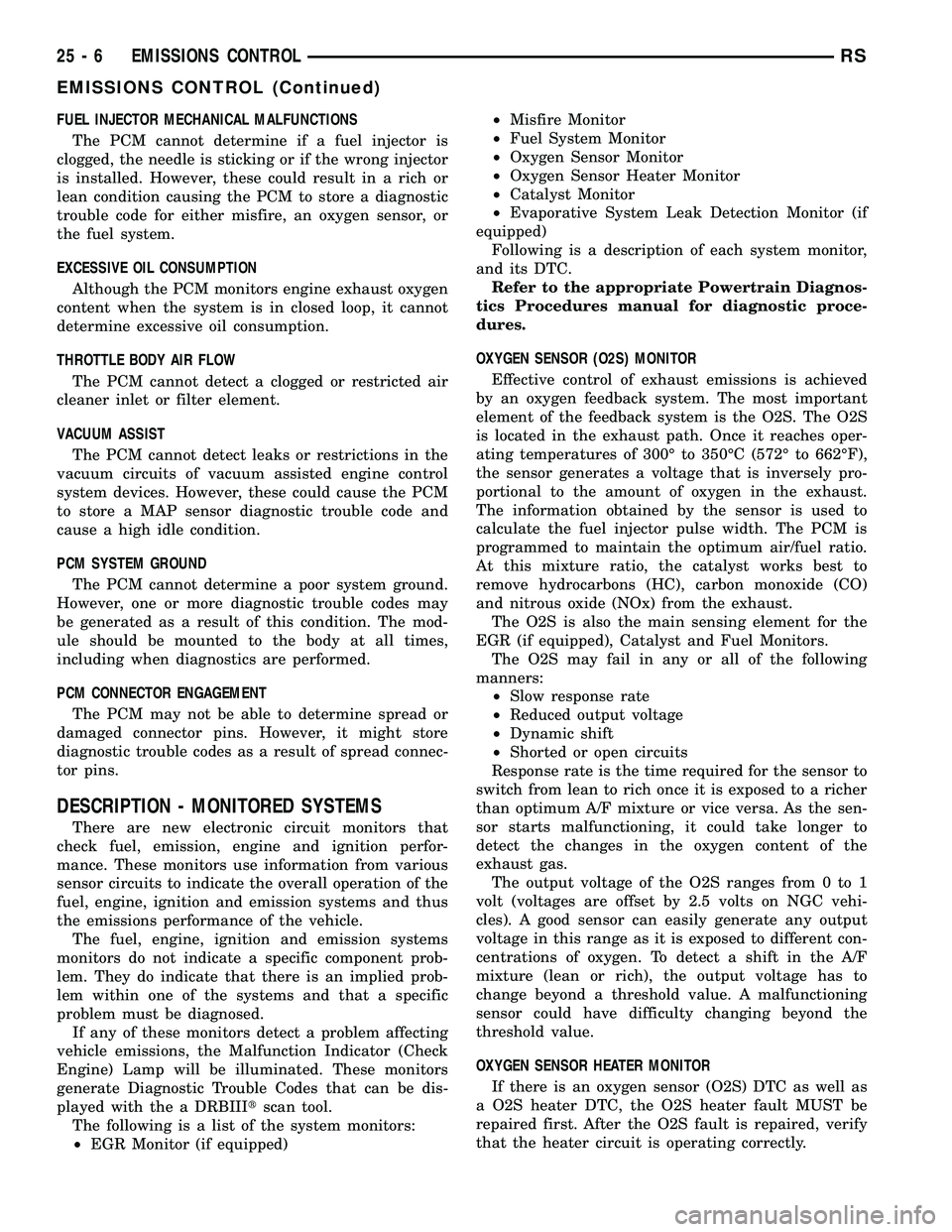
FUEL INJECTOR MECHANICAL MALFUNCTIONS
The PCM cannot determine if a fuel injector is
clogged, the needle is sticking or if the wrong injector
is installed. However, these could result in a rich or
lean condition causing the PCM to store a diagnostic
trouble code for either misfire, an oxygen sensor, or
the fuel system.
EXCESSIVE OIL CONSUMPTION
Although the PCM monitors engine exhaust oxygen
content when the system is in closed loop, it cannot
determine excessive oil consumption.
THROTTLE BODY AIR FLOW
The PCM cannot detect a clogged or restricted air
cleaner inlet or filter element.
VACUUM ASSIST
The PCM cannot detect leaks or restrictions in the
vacuum circuits of vacuum assisted engine control
system devices. However, these could cause the PCM
to store a MAP sensor diagnostic trouble code and
cause a high idle condition.
PCM SYSTEM GROUND
The PCM cannot determine a poor system ground.
However, one or more diagnostic trouble codes may
be generated as a result of this condition. The mod-
ule should be mounted to the body at all times,
including when diagnostics are performed.
PCM CONNECTOR ENGAGEMENT
The PCM may not be able to determine spread or
damaged connector pins. However, it might store
diagnostic trouble codes as a result of spread connec-
tor pins.
DESCRIPTION - MONITORED SYSTEMS
There are new electronic circuit monitors that
check fuel, emission, engine and ignition perfor-
mance. These monitors use information from various
sensor circuits to indicate the overall operation of the
fuel, engine, ignition and emission systems and thus
the emissions performance of the vehicle.
The fuel, engine, ignition and emission systems
monitors do not indicate a specific component prob-
lem. They do indicate that there is an implied prob-
lem within one of the systems and that a specific
problem must be diagnosed.
If any of these monitors detect a problem affecting
vehicle emissions, the Malfunction Indicator (Check
Engine) Lamp will be illuminated. These monitors
generate Diagnostic Trouble Codes that can be dis-
played with the a DRBIIItscan tool.
The following is a list of the system monitors:
²EGR Monitor (if equipped)²Misfire Monitor
²Fuel System Monitor
²Oxygen Sensor Monitor
²Oxygen Sensor Heater Monitor
²Catalyst Monitor
²Evaporative System Leak Detection Monitor (if
equipped)
Following is a description of each system monitor,
and its DTC.
Refer to the appropriate Powertrain Diagnos-
tics Procedures manual for diagnostic proce-
dures.
OXYGEN SENSOR (O2S) MONITOR
Effective control of exhaust emissions is achieved
by an oxygen feedback system. The most important
element of the feedback system is the O2S. The O2S
is located in the exhaust path. Once it reaches oper-
ating temperatures of 300É to 350ÉC (572É to 662ÉF),
the sensor generates a voltage that is inversely pro-
portional to the amount of oxygen in the exhaust.
The information obtained by the sensor is used to
calculate the fuel injector pulse width. The PCM is
programmed to maintain the optimum air/fuel ratio.
At this mixture ratio, the catalyst works best to
remove hydrocarbons (HC), carbon monoxide (CO)
and nitrous oxide (NOx) from the exhaust.
The O2S is also the main sensing element for the
EGR (if equipped), Catalyst and Fuel Monitors.
The O2S may fail in any or all of the following
manners:
²Slow response rate
²Reduced output voltage
²Dynamic shift
²Shorted or open circuits
Response rate is the time required for the sensor to
switch from lean to rich once it is exposed to a richer
than optimum A/F mixture or vice versa. As the sen-
sor starts malfunctioning, it could take longer to
detect the changes in the oxygen content of the
exhaust gas.
The output voltage of the O2S ranges from 0 to 1
volt (voltages are offset by 2.5 volts on NGC vehi-
cles). A good sensor can easily generate any output
voltage in this range as it is exposed to different con-
centrations of oxygen. To detect a shift in the A/F
mixture (lean or rich), the output voltage has to
change beyond a threshold value. A malfunctioning
sensor could have difficulty changing beyond the
threshold value.
OXYGEN SENSOR HEATER MONITOR
If there is an oxygen sensor (O2S) DTC as well as
a O2S heater DTC, the O2S heater fault MUST be
repaired first. After the O2S fault is repaired, verify
that the heater circuit is operating correctly.
25 - 6 EMISSIONS CONTROLRS
EMISSIONS CONTROL (Continued)
Page 2522 of 2585
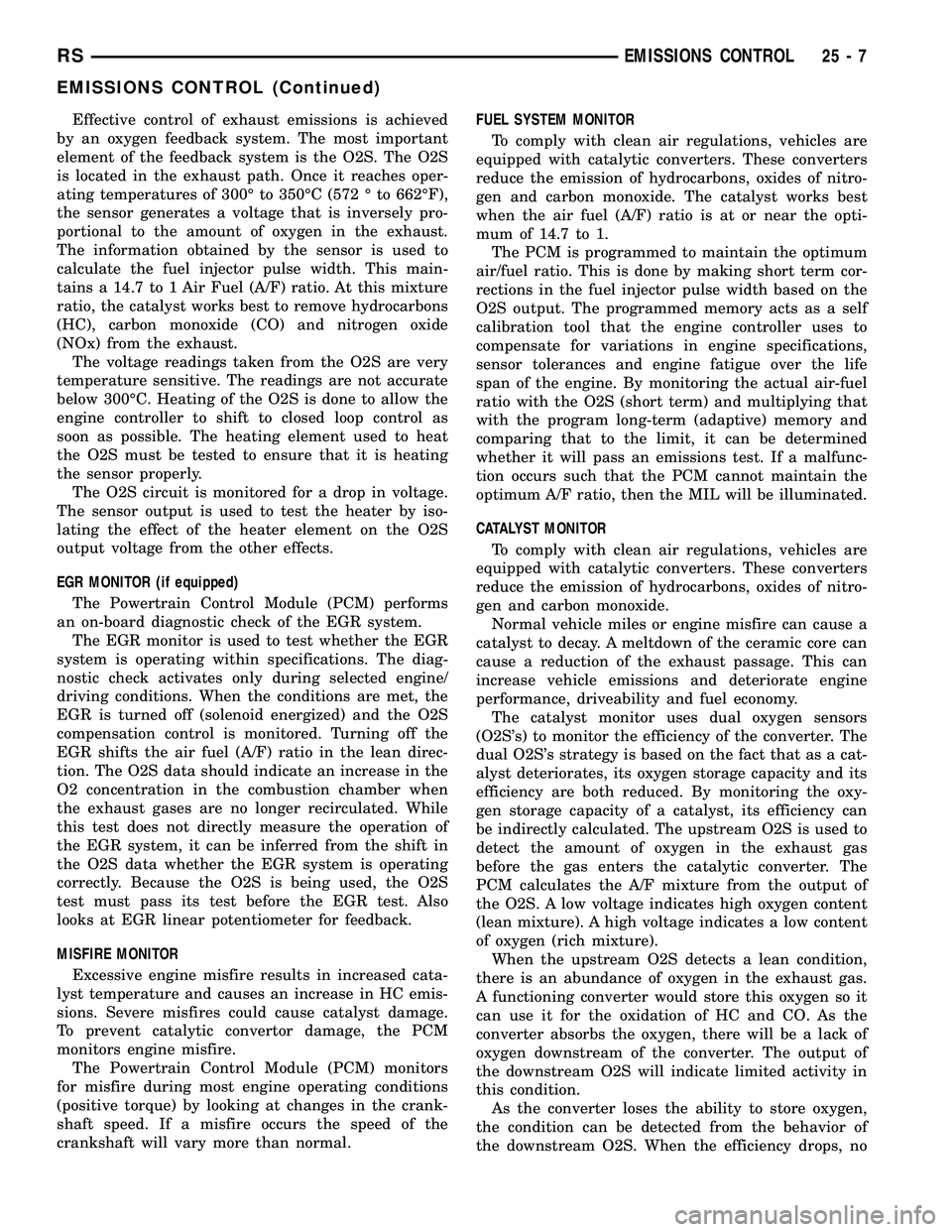
Effective control of exhaust emissions is achieved
by an oxygen feedback system. The most important
element of the feedback system is the O2S. The O2S
is located in the exhaust path. Once it reaches oper-
ating temperatures of 300É to 350ÉC (572 É to 662ÉF),
the sensor generates a voltage that is inversely pro-
portional to the amount of oxygen in the exhaust.
The information obtained by the sensor is used to
calculate the fuel injector pulse width. This main-
tains a 14.7 to 1 Air Fuel (A/F) ratio. At this mixture
ratio, the catalyst works best to remove hydrocarbons
(HC), carbon monoxide (CO) and nitrogen oxide
(NOx) from the exhaust.
The voltage readings taken from the O2S are very
temperature sensitive. The readings are not accurate
below 300ÉC. Heating of the O2S is done to allow the
engine controller to shift to closed loop control as
soon as possible. The heating element used to heat
the O2S must be tested to ensure that it is heating
the sensor properly.
The O2S circuit is monitored for a drop in voltage.
The sensor output is used to test the heater by iso-
lating the effect of the heater element on the O2S
output voltage from the other effects.
EGR MONITOR (if equipped)
The Powertrain Control Module (PCM) performs
an on-board diagnostic check of the EGR system.
The EGR monitor is used to test whether the EGR
system is operating within specifications. The diag-
nostic check activates only during selected engine/
driving conditions. When the conditions are met, the
EGR is turned off (solenoid energized) and the O2S
compensation control is monitored. Turning off the
EGR shifts the air fuel (A/F) ratio in the lean direc-
tion. The O2S data should indicate an increase in the
O2 concentration in the combustion chamber when
the exhaust gases are no longer recirculated. While
this test does not directly measure the operation of
the EGR system, it can be inferred from the shift in
the O2S data whether the EGR system is operating
correctly. Because the O2S is being used, the O2S
test must pass its test before the EGR test. Also
looks at EGR linear potentiometer for feedback.
MISFIRE MONITOR
Excessive engine misfire results in increased cata-
lyst temperature and causes an increase in HC emis-
sions. Severe misfires could cause catalyst damage.
To prevent catalytic convertor damage, the PCM
monitors engine misfire.
The Powertrain Control Module (PCM) monitors
for misfire during most engine operating conditions
(positive torque) by looking at changes in the crank-
shaft speed. If a misfire occurs the speed of the
crankshaft will vary more than normal.FUEL SYSTEM MONITOR
To comply with clean air regulations, vehicles are
equipped with catalytic converters. These converters
reduce the emission of hydrocarbons, oxides of nitro-
gen and carbon monoxide. The catalyst works best
when the air fuel (A/F) ratio is at or near the opti-
mum of 14.7 to 1.
The PCM is programmed to maintain the optimum
air/fuel ratio. This is done by making short term cor-
rections in the fuel injector pulse width based on the
O2S output. The programmed memory acts as a self
calibration tool that the engine controller uses to
compensate for variations in engine specifications,
sensor tolerances and engine fatigue over the life
span of the engine. By monitoring the actual air-fuel
ratio with the O2S (short term) and multiplying that
with the program long-term (adaptive) memory and
comparing that to the limit, it can be determined
whether it will pass an emissions test. If a malfunc-
tion occurs such that the PCM cannot maintain the
optimum A/F ratio, then the MIL will be illuminated.
CATALYST MONITOR
To comply with clean air regulations, vehicles are
equipped with catalytic converters. These converters
reduce the emission of hydrocarbons, oxides of nitro-
gen and carbon monoxide.
Normal vehicle miles or engine misfire can cause a
catalyst to decay. A meltdown of the ceramic core can
cause a reduction of the exhaust passage. This can
increase vehicle emissions and deteriorate engine
performance, driveability and fuel economy.
The catalyst monitor uses dual oxygen sensors
(O2S's) to monitor the efficiency of the converter. The
dual O2S's strategy is based on the fact that as a cat-
alyst deteriorates, its oxygen storage capacity and its
efficiency are both reduced. By monitoring the oxy-
gen storage capacity of a catalyst, its efficiency can
be indirectly calculated. The upstream O2S is used to
detect the amount of oxygen in the exhaust gas
before the gas enters the catalytic converter. The
PCM calculates the A/F mixture from the output of
the O2S. A low voltage indicates high oxygen content
(lean mixture). A high voltage indicates a low content
of oxygen (rich mixture).
When the upstream O2S detects a lean condition,
there is an abundance of oxygen in the exhaust gas.
A functioning converter would store this oxygen so it
can use it for the oxidation of HC and CO. As the
converter absorbs the oxygen, there will be a lack of
oxygen downstream of the converter. The output of
the downstream O2S will indicate limited activity in
this condition.
As the converter loses the ability to store oxygen,
the condition can be detected from the behavior of
the downstream O2S. When the efficiency drops, no
RSEMISSIONS CONTROL25-7
EMISSIONS CONTROL (Continued)
Page 2544 of 2585
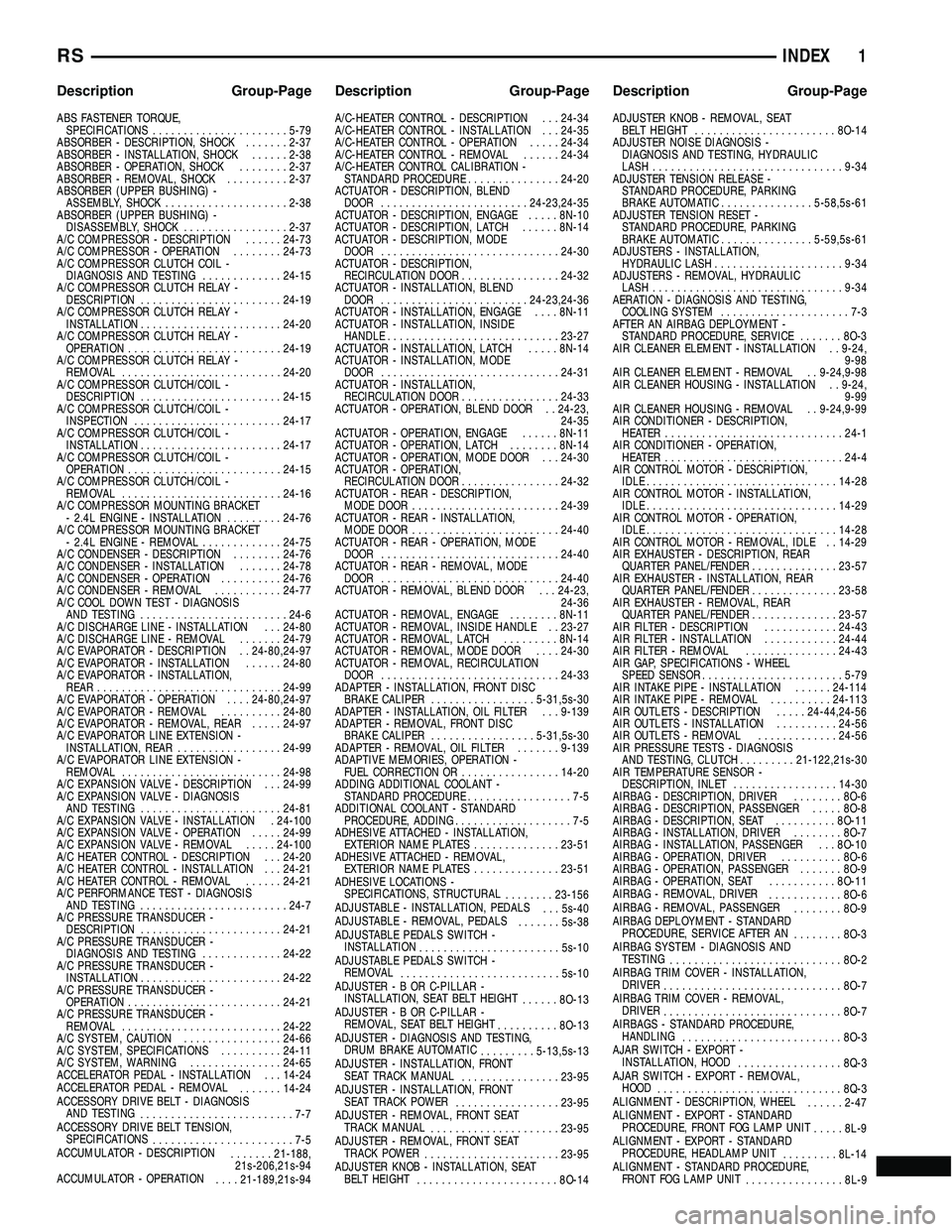
INDEX
ABS FASTENER TORQUE,
SPECIFICATIONS......................5-79
ABSORBER - DESCRIPTION, SHOCK.......2-37
ABSORBER - INSTALLATION, SHOCK......2-38
ABSORBER - OPERATION, SHOCK........2-37
ABSORBER - REMOVAL, SHOCK..........2-37
ABSORBER (UPPER BUSHING) -
ASSEMBLY, SHOCK....................2-38
ABSORBER (UPPER BUSHING) -
DISASSEMBLY, SHOCK.................2-37
A/C COMPRESSOR - DESCRIPTION......24-73
A/C COMPRESSOR - OPERATION........24-73
A/C COMPRESSOR CLUTCH COIL -
DIAGNOSIS AND TESTING.............24-15
A/C COMPRESSOR CLUTCH RELAY -
DESCRIPTION.......................24-19
A/C COMPRESSOR CLUTCH RELAY -
INSTALLATION.......................24-20
A/C COMPRESSOR CLUTCH RELAY -
OPERATION.........................24-19
A/C COMPRESSOR CLUTCH RELAY -
REMOVAL..........................24-20
A/C COMPRESSOR CLUTCH/COIL -
DESCRIPTION.......................24-15
A/C COMPRESSOR CLUTCH/COIL -
INSPECTION........................24-17
A/C COMPRESSOR CLUTCH/COIL -
INSTALLATION.......................24-17
A/C COMPRESSOR CLUTCH/COIL -
OPERATION.........................24-15
A/C COMPRESSOR CLUTCH/COIL -
REMOVAL..........................24-16
A/C COMPRESSOR MOUNTING BRACKET
- 2.4L ENGINE - INSTALLATION.........24-76
A/C COMPRESSOR MOUNTING BRACKET
- 2.4L ENGINE - REMOVAL.............24-75
A/C CONDENSER - DESCRIPTION........24-76
A/C CONDENSER - INSTALLATION.......24-78
A/C CONDENSER - OPERATION..........24-76
A/C CONDENSER - REMOVAL...........24-77
A/C COOL DOWN TEST - DIAGNOSIS
AND TESTING........................24-6
A/C DISCHARGE LINE - INSTALLATION . . . 24-80
A/C DISCHARGE LINE - REMOVAL.......24-79
A/C EVAPORATOR - DESCRIPTION . . 24-80,24-97
A/C EVAPORATOR - INSTALLATION......24-80
A/C EVAPORATOR - INSTALLATION,
REAR..............................24-99
A/C EVAPORATOR - OPERATION....24-80,24-97
A/C EVAPORATOR - REMOVAL..........24-80
A/C EVAPORATOR - REMOVAL, REAR.....24-97
A/C EVAPORATOR LINE EXTENSION -
INSTALLATION, REAR.................24-99
A/C EVAPORATOR LINE EXTENSION -
REMOVAL..........................24-98
A/C EXPANSION VALVE - DESCRIPTION . . . 24-99
A/C EXPANSION VALVE - DIAGNOSIS
AND TESTING.......................24-81
A/C EXPANSION VALVE - INSTALLATION . 24-100
A/C EXPANSION VALVE - OPERATION.....24-99
A/C EXPANSION VALVE - REMOVAL.....24-100
A/C HEATER CONTROL - DESCRIPTION . . . 24-20
A/C HEATER CONTROL - INSTALLATION . . . 24-21
A/C HEATER CONTROL - REMOVAL......24-21
A/C PERFORMANCE TEST - DIAGNOSIS
AND TESTING........................24-7
A/C PRESSURE TRANSDUCER -
DESCRIPTION.......................24-21
A/C PRESSURE TRANSDUCER -
DIAGNOSIS AND TESTING.............24-22
A/C PRESSURE TRANSDUCER -
INSTALLATION.......................24-22
A/C PRESSURE TRANSDUCER -
OPERATION.........................24-21
A/C PRESSURE TRANSDUCER -
REMOVAL..........................24-22
A/C SYSTEM, CAUTION................24-66
A/C SYSTEM, SPECIFICATIONS..........24-11
A/C SYSTEM, WARNING...............24-65
ACCELERATOR PEDAL - INSTALLATION . . . 14-24
ACCELERATOR PEDAL - REMOVAL
.......14-24
ACCESSORY DRIVE BELT - DIAGNOSIS
AND TESTING
.........................7-7
ACCESSORY DRIVE BELT TENSION,
SPECIFICATIONS
.......................7-5
ACCUMULATOR - DESCRIPTION
.......21-188,
21s-206,21s-94
ACCUMULATOR - OPERATION
....21-189,21s-94A/C-HEATER CONTROL - DESCRIPTION . . . 24-34
A/C-HEATER CONTROL - INSTALLATION . . . 24-35
A/C-HEATER CONTROL - OPERATION.....24-34
A/C-HEATER CONTROL - REMOVAL......24-34
A/C-HEATER CONTROL CALIBRATION -
STANDARD PROCEDURE...............24-20
ACTUATOR - DESCRIPTION, BLEND
DOOR........................24-23,24-35
ACTUATOR - DESCRIPTION, ENGAGE.....8N-10
ACTUATOR - DESCRIPTION, LATCH......8N-14
ACTUATOR - DESCRIPTION, MODE
DOOR.............................24-30
ACTUATOR - DESCRIPTION,
RECIRCULATION DOOR................24-32
ACTUATOR - INSTALLATION, BLEND
DOOR........................24-23,24-36
ACTUATOR - INSTALLATION, ENGAGE....8N-11
ACTUATOR - INSTALLATION, INSIDE
HANDLE............................23-27
ACTUATOR - INSTALLATION, LATCH.....8N-14
ACTUATOR - INSTALLATION, MODE
DOOR.............................24-31
ACTUATOR - INSTALLATION,
RECIRCULATION DOOR................24-33
ACTUATOR - OPERATION, BLEND DOOR . . 24-23,
24-35
ACTUATOR - OPERATION, ENGAGE......8N-11
ACTUATOR - OPERATION, LATCH........8N-14
ACTUATOR - OPERATION, MODE DOOR . . . 24-30
ACTUATOR - OPERATION,
RECIRCULATION DOOR................24-32
ACTUATOR - REAR - DESCRIPTION,
MODE DOOR........................24-39
ACTUATOR - REAR - INSTALLATION,
MODE DOOR........................24-40
ACTUATOR - REAR - OPERATION, MODE
DOOR.............................24-40
ACTUATOR - REAR - REMOVAL, MODE
DOOR.............................24-40
ACTUATOR - REMOVAL, BLEND DOOR . . . 24-23,
24-36
ACTUATOR - REMOVAL, ENGAGE........8N-11
ACTUATOR - REMOVAL, INSIDE HANDLE . . 23-27
ACTUATOR - REMOVAL, LATCH.........8N-14
ACTUATOR - REMOVAL, MODE DOOR....24-30
ACTUATOR - REMOVAL, RECIRCULATION
DOOR.............................24-33
ADAPTER - INSTALLATION, FRONT DISC
BRAKE CALIPER.................5-31,5s-30
ADAPTER - INSTALLATION, OIL FILTER . . . 9-139
ADAPTER - REMOVAL, FRONT DISC
BRAKE CALIPER.................5-31,5s-30
ADAPTER - REMOVAL, OIL FILTER.......9-139
ADAPTIVE MEMORIES, OPERATION -
FUEL CORRECTION OR................14-20
ADDING ADDITIONAL COOLANT -
STANDARD PROCEDURE.................7-5
ADDITIONAL COOLANT - STANDARD
PROCEDURE, ADDING...................7-5
ADHESIVE ATTACHED - INSTALLATION,
EXTERIOR NAME PLATES..............23-51
ADHESIVE ATTACHED - REMOVAL,
EXTERIOR NAME PLATES..............23-51
ADHESIVE LOCATIONS -
SPECIFICATIONS, STRUCTURAL
........23-156
ADJUSTABLE - INSTALLATION, PEDALS
. . . 5s-40
ADJUSTABLE - REMOVAL, PEDALS
.......5s-38
ADJUSTABLE PEDALS SWITCH -
INSTALLATION
.......................5s-10
ADJUSTABLE PEDALS SWITCH -
REMOVAL
..........................5s-10
ADJUSTER-BORC-PILLAR -
INSTALLATION, SEAT BELT HEIGHT
......8O-13
ADJUSTER-BORC-PILLAR -
REMOVAL, SEAT BELT HEIGHT
..........8O-13
ADJUSTER - DIAGNOSIS AND TESTING,
DRUM BRAKE AUTOMATIC
.........5-13,5s-13
ADJUSTER - INSTALLATION, FRONT
SEAT TRACK MANUAL
................23-95
ADJUSTER - INSTALLATION, FRONT
SEAT TRACK POWER
.................23-95
ADJUSTER - REMOVAL, FRONT SEAT
TRACK MANUAL
.....................23-95
ADJUSTER - REMOVAL, FRONT SEAT
TRACK POWER
......................23-95
ADJUSTER KNOB - INSTALLATION, SEAT
BELT HEIGHT
.......................8O-14ADJUSTER KNOB - REMOVAL, SEAT
BELT HEIGHT.......................8O-14
ADJUSTER NOISE DIAGNOSIS -
DIAGNOSIS AND TESTING, HYDRAULIC
LASH...............................9-34
ADJUSTER TENSION RELEASE -
STANDARD PROCEDURE, PARKING
BRAKE AUTOMATIC...............5-58,5s-61
ADJUSTER TENSION RESET -
STANDARD PROCEDURE, PARKING
BRAKE AUTOMATIC...............5-59,5s-61
ADJUSTERS - INSTALLATION,
HYDRAULIC LASH.....................9-34
ADJUSTERS - REMOVAL, HYDRAULIC
LASH...............................9-34
AERATION - DIAGNOSIS AND TESTING,
COOLING SYSTEM.....................7-3
AFTER AN AIRBAG DEPLOYMENT -
STANDARD PROCEDURE, SERVICE.......8O-3
AIR CLEANER ELEMENT - INSTALLATION . . 9-24,
9-98
AIR CLEANER ELEMENT - REMOVAL . . 9-24,9-98
AIR CLEANER HOUSING - INSTALLATION . . 9-24,
9-99
AIR CLEANER HOUSING - REMOVAL . . 9-24,9-99
AIR CONDITIONER - DESCRIPTION,
HEATER .............................24-1
AIR CONDITIONER - OPERATION,
HEATER .............................24-4
AIR CONTROL MOTOR - DESCRIPTION,
IDLE...............................14-28
AIR CONTROL MOTOR - INSTALLATION,
IDLE...............................14-29
AIR CONTROL MOTOR - OPERATION,
IDLE...............................14-28
AIR CONTROL MOTOR - REMOVAL, IDLE . . 14-29
AIR EXHAUSTER - DESCRIPTION, REAR
QUARTER PANEL/FENDER..............23-57
AIR EXHAUSTER - INSTALLATION, REAR
QUARTER PANEL/FENDER..............23-58
AIR EXHAUSTER - REMOVAL, REAR
QUARTER PANEL/FENDER..............23-57
AIR FILTER - DESCRIPTION............24-43
AIR FILTER - INSTALLATION............24-44
AIR FILTER - REMOVAL...............24-43
AIR GAP, SPECIFICATIONS - WHEEL
SPEED SENSOR.......................5-79
AIR INTAKE PIPE - INSTALLATION......24-114
AIR INTAKE PIPE - REMOVAL..........24-113
AIR OUTLETS - DESCRIPTION.....24-44,24-56
AIR OUTLETS - INSTALLATION..........24-56
AIR OUTLETS - REMOVAL.............24-56
AIR PRESSURE TESTS - DIAGNOSIS
AND TESTING, CLUTCH.........21-122,21s-30
AIR TEMPERATURE SENSOR -
DESCRIPTION, INLET.................14-30
AIRBAG - DESCRIPTION, DRIVER........8O-6
AIRBAG - DESCRIPTION, PASSENGER.....8O-8
AIRBAG - DESCRIPTION, SEAT..........8O-11
AIRBAG - INSTALLATION, DRIVER........8O-7
AIRBAG - INSTALLATION, PASSENGER . . . 8O-10
AIRBAG - OPERATION, DRIVER..........8O-6
AIRBAG - OPERATION, PASSENGER.......8O-9
AIRBAG - OPERATION, SEAT...........8O-11
AIRBAG - REMOVAL, DRIVER
............8O-6
AIRBAG - REMOVAL, PASSENGER
........8O-9
AIRBAG DEPLOYMENT - STANDARD
PROCEDURE, SERVICE AFTER AN
........8O-3
AIRBAG SYSTEM - DIAGNOSIS AND
TESTING
............................8O-2
AIRBAG TRIM COVER - INSTALLATION,
DRIVER
.............................8O-7
AIRBAG TRIM COVER - REMOVAL,
DRIVER
.............................8O-7
AIRBAGS - STANDARD PROCEDURE,
HANDLING
..........................8O-3
AJAR SWITCH - EXPORT -
INSTALLATION, HOOD
.................8Q-3
AJAR SWITCH - EXPORT - REMOVAL,
HOOD
..............................8Q-3
ALIGNMENT - DESCRIPTION, WHEEL
......2-47
ALIGNMENT - EXPORT - STANDARD
PROCEDURE, FRONT FOG LAMP UNIT
.....8L-9
ALIGNMENT - EXPORT - STANDARD
PROCEDURE, HEADLAMP UNIT
.........8L-14
ALIGNMENT - STANDARD PROCEDURE,
FRONT FOG LAMP UNIT
................8L-9
RSINDEX1
Description Group-Page Description Group-Page Description Group-Page
Page 2547 of 2585
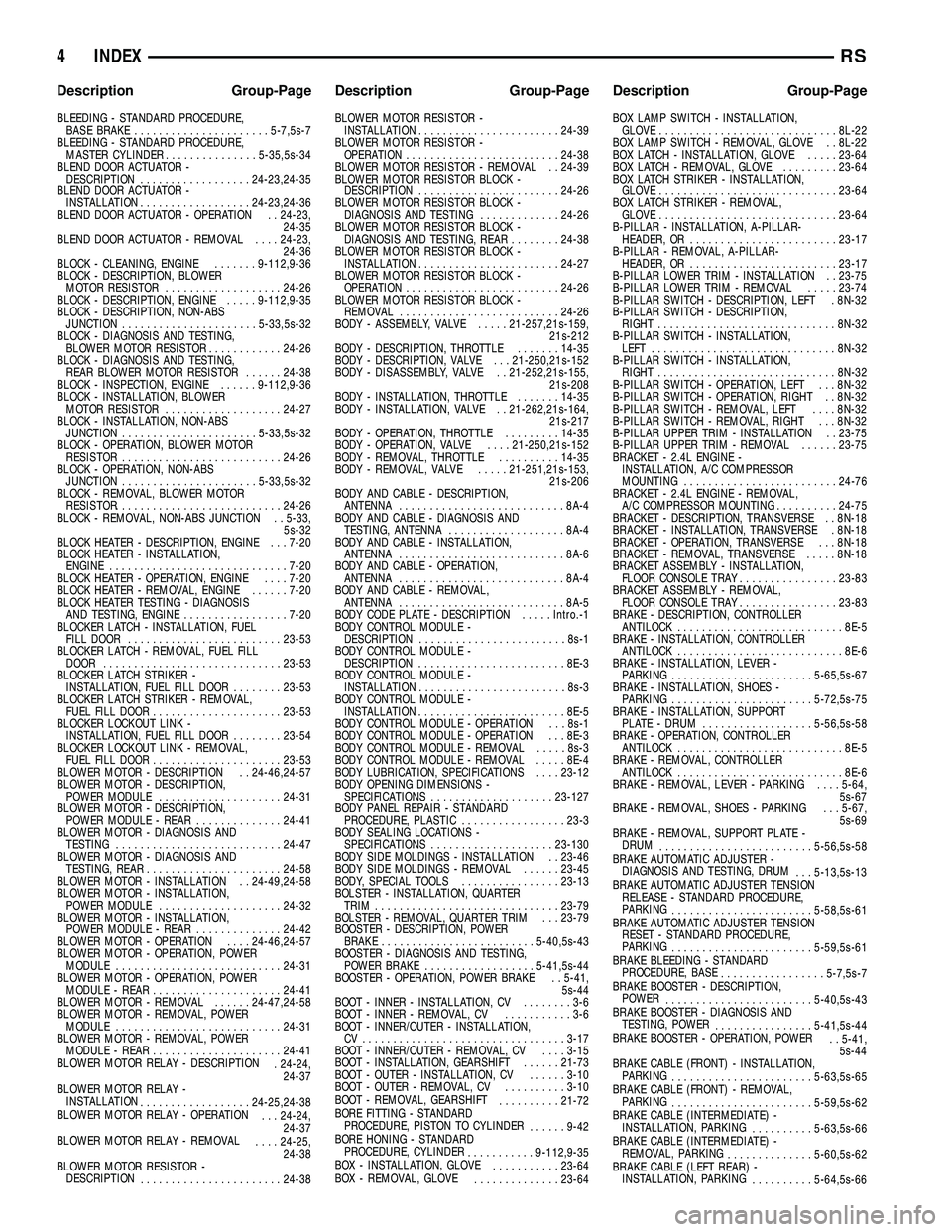
BLEEDING - STANDARD PROCEDURE,
BASE BRAKE......................5-7,5s-7
BLEEDING - STANDARD PROCEDURE,
MASTER CYLINDER...............5-35,5s-34
BLEND DOOR ACTUATOR -
DESCRIPTION..................24-23,24-35
BLEND DOOR ACTUATOR -
INSTALLATION..................24-23,24-36
BLEND DOOR ACTUATOR - OPERATION . . 24-23,
24-35
BLEND DOOR ACTUATOR - REMOVAL....24-23,
24-36
BLOCK - CLEANING, ENGINE.......9-112,9-36
BLOCK - DESCRIPTION, BLOWER
MOTOR RESISTOR...................24-26
BLOCK - DESCRIPTION, ENGINE.....9-112,9-35
BLOCK - DESCRIPTION, NON-ABS
JUNCTION......................5-33,5s-32
BLOCK - DIAGNOSIS AND TESTING,
BLOWER MOTOR RESISTOR............24-26
BLOCK - DIAGNOSIS AND TESTING,
REAR BLOWER MOTOR RESISTOR......24-38
BLOCK - INSPECTION, ENGINE......9-112,9-36
BLOCK - INSTALLATION, BLOWER
MOTOR RESISTOR...................24-27
BLOCK - INSTALLATION, NON-ABS
JUNCTION......................5-33,5s-32
BLOCK - OPERATION, BLOWER MOTOR
RESISTOR..........................24-26
BLOCK - OPERATION, NON-ABS
JUNCTION......................5-33,5s-32
BLOCK - REMOVAL, BLOWER MOTOR
RESISTOR...........................24-26
BLOCK - REMOVAL, NON-ABS JUNCTION . . 5-33,
5s-32
BLOCK HEATER - DESCRIPTION, ENGINE . . . 7-20
BLOCK HEATER - INSTALLATION,
ENGINE.............................7-20
BLOCK HEATER - OPERATION, ENGINE....7-20
BLOCK HEATER - REMOVAL, ENGINE......7-20
BLOCK HEATER TESTING - DIAGNOSIS
AND TESTING, ENGINE.................7-20
BLOCKER LATCH - INSTALLATION, FUEL
FILL DOOR.........................23-53
BLOCKER LATCH - REMOVAL, FUEL FILL
DOOR.............................23-53
BLOCKER LATCH STRIKER -
INSTALLATION, FUEL FILL DOOR........23-53
BLOCKER LATCH STRIKER - REMOVAL,
FUEL FILL DOOR.....................23-53
BLOCKER LOCKOUT LINK -
INSTALLATION, FUEL FILL DOOR........23-54
BLOCKER LOCKOUT LINK - REMOVAL,
FUEL FILL DOOR.....................23-53
BLOWER MOTOR - DESCRIPTION . . 24-46,24-57
BLOWER MOTOR - DESCRIPTION,
POWER MODULE....................24-31
BLOWER MOTOR - DESCRIPTION,
POWER MODULE - REAR..............24-41
BLOWER MOTOR - DIAGNOSIS AND
TESTING...........................24-47
BLOWER MOTOR - DIAGNOSIS AND
TESTING, REAR......................24-58
BLOWER MOTOR - INSTALLATION . . 24-49,24-58
BLOWER MOTOR - INSTALLATION,
POWER MODULE....................24-32
BLOWER MOTOR - INSTALLATION,
POWER MODULE - REAR..............24-42
BLOWER MOTOR - OPERATION....24-46,24-57
BLOWER MOTOR - OPERATION, POWER
MODULE...........................24-31
BLOWER MOTOR - OPERATION, POWER
MODULE - REAR.....................24-41
BLOWER MOTOR - REMOVAL......24-47,24-58
BLOWER MOTOR - REMOVAL, POWER
MODULE...........................24-31
BLOWER MOTOR - REMOVAL, POWER
MODULE - REAR.....................24-41
BLOWER MOTOR RELAY - DESCRIPTION
. 24-24,
24-37
BLOWER MOTOR RELAY -
INSTALLATION
..................24-25,24-38
BLOWER MOTOR RELAY - OPERATION
. . . 24-24,
24-37
BLOWER MOTOR RELAY - REMOVAL
....24-25,
24-38
BLOWER MOTOR RESISTOR -
DESCRIPTION
.......................24-38BLOWER MOTOR RESISTOR -
INSTALLATION.......................24-39
BLOWER MOTOR RESISTOR -
OPERATION.........................24-38
BLOWER MOTOR RESISTOR - REMOVAL . . 24-39
BLOWER MOTOR RESISTOR BLOCK -
DESCRIPTION.......................24-26
BLOWER MOTOR RESISTOR BLOCK -
DIAGNOSIS AND TESTING.............24-26
BLOWER MOTOR RESISTOR BLOCK -
DIAGNOSIS AND TESTING, REAR........24-38
BLOWER MOTOR RESISTOR BLOCK -
INSTALLATION.......................24-27
BLOWER MOTOR RESISTOR BLOCK -
OPERATION.........................24-26
BLOWER MOTOR RESISTOR BLOCK -
REMOVAL..........................24-26
BODY - ASSEMBLY, VALVE.....21-257,21s-159,
21s-212
BODY - DESCRIPTION, THROTTLE.......14-35
BODY - DESCRIPTION, VALVE . . . 21-250,21s-152
BODY - DISASSEMBLY, VALVE . . 21-252,21s-155,
21s-208
BODY - INSTALLATION, THROTTLE.......14-35
BODY - INSTALLATION, VALVE . . 21-262,21s-164,
21s-217
BODY - OPERATION, THROTTLE.........14-35
BODY - OPERATION, VALVE....21-250,21s-152
BODY - REMOVAL, THROTTLE..........14-35
BODY - REMOVAL, VALVE.....21-251,21s-153,
21s-206
BODY AND CABLE - DESCRIPTION,
ANTENNA...........................8A-4
BODY AND CABLE - DIAGNOSIS AND
TESTING, ANTENNA...................8A-4
BODY AND CABLE - INSTALLATION,
ANTENNA...........................8A-6
BODY AND CABLE - OPERATION,
ANTENNA...........................8A-4
BODY AND CABLE - REMOVAL,
ANTENNA...........................8A-5
BODY CODE PLATE - DESCRIPTION.....Intro.-1
BODY CONTROL MODULE -
DESCRIPTION........................8s-1
BODY CONTROL MODULE -
DESCRIPTION........................8E-3
BODY CONTROL MODULE -
INSTALLATION........................8s-3
BODY CONTROL MODULE -
INSTALLATION........................8E-5
BODY CONTROL MODULE - OPERATION . . . 8s-1
BODY CONTROL MODULE - OPERATION . . . 8E-3
BODY CONTROL MODULE - REMOVAL.....8s-3
BODY CONTROL MODULE - REMOVAL.....8E-4
BODY LUBRICATION, SPECIFICATIONS....23-12
BODY OPENING DIMENSIONS -
SPECIFICATIONS....................23-127
BODY PANEL REPAIR - STANDARD
PROCEDURE, PLASTIC.................23-3
BODY SEALING LOCATIONS -
SPECIFICATIONS....................23-130
BODY SIDE MOLDINGS - INSTALLATION . . 23-46
BODY SIDE MOLDINGS - REMOVAL......23-45
BODY, SPECIAL TOOLS................23-13
BOLSTER - INSTALLATION, QUARTER
TRIM..............................23-79
BOLSTER - REMOVAL, QUARTER TRIM . . . 23-79
BOOSTER - DESCRIPTION, POWER
BRAKE.........................5-40,5s-43
BOOSTER - DIAGNOSIS AND TESTING,
POWER BRAKE..................5-41,5s-44
BOOSTER - OPERATION, POWER BRAKE . . 5-41,
5s-44
BOOT - INNER - INSTALLATION, CV........3-6
BOOT - INNER - REMOVAL, CV...........3-6
BOOT - INNER/OUTER - INSTALLATION,
CV .................................3-17
BOOT - INNER/OUTER - REMOVAL, CV....3-15
BOOT - INSTALLATION, GEARSHIFT......21-73
BOOT - OUTER - INSTALLATION, CV......3-10
BOOT - OUTER - REMOVAL, CV..........3-10
BOOT - REMOVAL, GEARSHIFT
..........21-72
BORE FITTING - STANDARD
PROCEDURE, PISTON TO CYLINDER
......9-42
BORE HONING - STANDARD
PROCEDURE, CYLINDER
...........9-112,9-35
BOX - INSTALLATION, GLOVE
...........23-64
BOX - REMOVAL, GLOVE
..............23-64BOX LAMP SWITCH - INSTALLATION,
GLOVE.............................8L-22
BOX LAMP SWITCH - REMOVAL, GLOVE . . 8L-22
BOX LATCH - INSTALLATION, GLOVE.....23-64
BOX LATCH - REMOVAL, GLOVE.........23-64
BOX LATCH STRIKER - INSTALLATION,
GLOVE.............................23-64
BOX LATCH STRIKER - REMOVAL,
GLOVE.............................23-64
B-PILLAR - INSTALLATION, A-PILLAR-
HEADER, OR........................23-17
B-PILLAR - REMOVAL, A-PILLAR-
HEADER, OR........................23-17
B-PILLAR LOWER TRIM - INSTALLATION . . 23-75
B-PILLAR LOWER TRIM - REMOVAL.....23-74
B-PILLAR SWITCH - DESCRIPTION, LEFT . 8N-32
B-PILLAR SWITCH - DESCRIPTION,
RIGHT.............................8N-32
B-PILLAR SWITCH - INSTALLATION,
LEFT..............................8N-32
B-PILLAR SWITCH - INSTALLATION,
RIGHT.............................8N-32
B-PILLAR SWITCH - OPERATION, LEFT . . . 8N-32
B-PILLAR SWITCH - OPERATION, RIGHT . . 8N-32
B-PILLAR SWITCH - REMOVAL, LEFT....8N-32
B-PILLAR SWITCH - REMOVAL, RIGHT . . . 8N-32
B-PILLAR UPPER TRIM - INSTALLATION . . 23-75
B-PILLAR UPPER TRIM - REMOVAL......23-75
BRACKET - 2.4L ENGINE -
INSTALLATION, A/C COMPRESSOR
MOUNTING.........................24-76
BRACKET - 2.4L ENGINE - REMOVAL,
A/C COMPRESSOR MOUNTING..........24-75
BRACKET - DESCRIPTION, TRANSVERSE . . 8N-18
BRACKET - INSTALLATION, TRANSVERSE . 8N-18
BRACKET - OPERATION, TRANSVERSE . . . 8N-18
BRACKET - REMOVAL, TRANSVERSE.....8N-18
BRACKET ASSEMBLY - INSTALLATION,
FLOOR CONSOLE TRAY................23-83
BRACKET ASSEMBLY - REMOVAL,
FLOOR CONSOLE TRAY................23-83
BRAKE - DESCRIPTION, CONTROLLER
ANTILOCK...........................8E-5
BRAKE - INSTALLATION, CONTROLLER
ANTILOCK...........................8E-6
BRAKE - INSTALLATION, LEVER -
PARKING.......................5-65,5s-67
BRAKE - INSTALLATION, SHOES -
PARKING.......................5-72,5s-75
BRAKE - INSTALLATION, SUPPORT
PLATE - DRUM..................5-56,5s-58
BRAKE - OPERATION, CONTROLLER
ANTILOCK...........................8E-5
BRAKE - REMOVAL, CONTROLLER
ANTILOCK...........................8E-6
BRAKE - REMOVAL, LEVER - PARKING....5-64,
5s-67
BRAKE - REMOVAL, SHOES - PARKING . . . 5-67,
5s-69
BRAKE - REMOVAL, SUPPORT PLATE -
DRUM
.........................5-56,5s-58
BRAKE AUTOMATIC ADJUSTER -
DIAGNOSIS AND TESTING, DRUM
. . . 5-13,5s-13
BRAKE AUTOMATIC ADJUSTER TENSION
RELEASE - STANDARD PROCEDURE,
PARKING
.......................5-58,5s-61
BRAKE AUTOMATIC ADJUSTER TENSION
RESET - STANDARD PROCEDURE,
PARKING
.......................5-59,5s-61
BRAKE BLEEDING - STANDARD
PROCEDURE, BASE
.................5-7,5s-7
BRAKE BOOSTER - DESCRIPTION,
POWER
........................5-40,5s-43
BRAKE BOOSTER - DIAGNOSIS AND
TESTING, POWER
................5-41,5s-44
BRAKE BOOSTER - OPERATION, POWER
. . 5-41,
5s-44
BRAKE CABLE (FRONT) - INSTALLATION,
PARKING
.......................5-63,5s-65
BRAKE CABLE (FRONT) - REMOVAL,
PARKING
.......................5-59,5s-62
BRAKE CABLE (INTERMEDIATE) -
INSTALLATION, PARKING
..........5-63,5s-66
BRAKE CABLE (INTERMEDIATE) -
REMOVAL, PARKING
..............5-60,5s-62
BRAKE CABLE (LEFT REAR) -
INSTALLATION, PARKING
..........5-64,5s-66
4 INDEXRS
Description Group-Page Description Group-Page Description Group-Page
Page 2548 of 2585
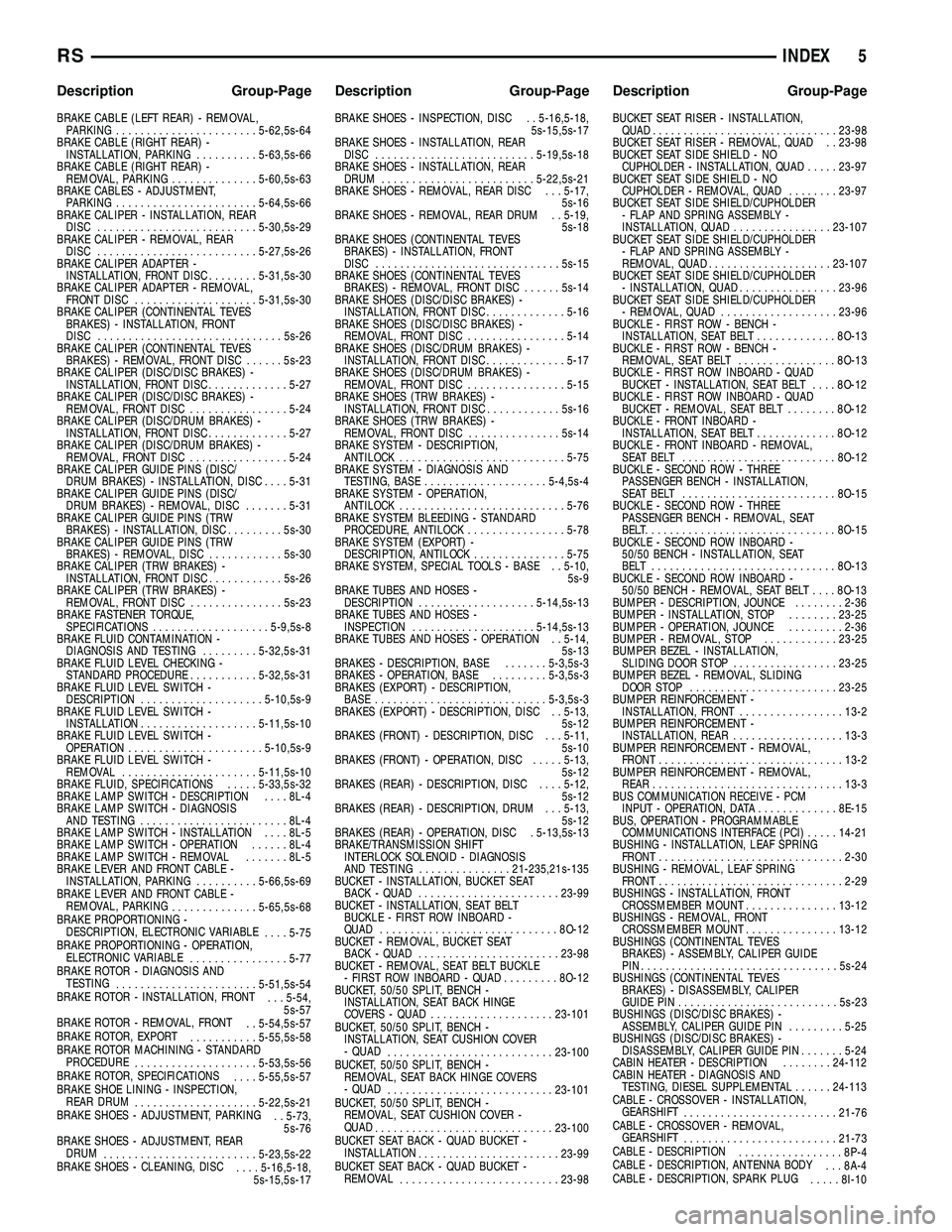
BRAKE CABLE (LEFT REAR) - REMOVAL,
PARKING.......................5-62,5s-64
BRAKE CABLE (RIGHT REAR) -
INSTALLATION, PARKING..........5-63,5s-66
BRAKE CABLE (RIGHT REAR) -
REMOVAL, PARKING..............5-60,5s-63
BRAKE CABLES - ADJUSTMENT,
PARKING.......................5-64,5s-66
BRAKE CALIPER - INSTALLATION, REAR
DISC..........................5-30,5s-29
BRAKE CALIPER - REMOVAL, REAR
DISC..........................5-27,5s-26
BRAKE CALIPER ADAPTER -
INSTALLATION, FRONT DISC........5-31,5s-30
BRAKE CALIPER ADAPTER - REMOVAL,
FRONT DISC....................5-31,5s-30
BRAKE CALIPER (CONTINENTAL TEVES
BRAKES) - INSTALLATION, FRONT
DISC..............................5s-26
BRAKE CALIPER (CONTINENTAL TEVES
BRAKES) - REMOVAL, FRONT DISC......5s-23
BRAKE CALIPER (DISC/DISC BRAKES) -
INSTALLATION, FRONT DISC.............5-27
BRAKE CALIPER (DISC/DISC BRAKES) -
REMOVAL, FRONT DISC................5-24
BRAKE CALIPER (DISC/DRUM BRAKES) -
INSTALLATION, FRONT DISC.............5-27
BRAKE CALIPER (DISC/DRUM BRAKES) -
REMOVAL, FRONT DISC................5-24
BRAKE CALIPER GUIDE PINS (DISC/
DRUM BRAKES) - INSTALLATION, DISC....5-31
BRAKE CALIPER GUIDE PINS (DISC/
DRUM BRAKES) - REMOVAL, DISC.......5-31
BRAKE CALIPER GUIDE PINS (TRW
BRAKES) - INSTALLATION, DISC.........5s-30
BRAKE CALIPER GUIDE PINS (TRW
BRAKES) - REMOVAL, DISC............5s-30
BRAKE CALIPER (TRW BRAKES) -
INSTALLATION, FRONT DISC............5s-26
BRAKE CALIPER (TRW BRAKES) -
REMOVAL, FRONT DISC...............5s-23
BRAKE FASTENER TORQUE,
SPECIFICATIONS...................5-9,5s-8
BRAKE FLUID CONTAMINATION -
DIAGNOSIS AND TESTING.........5-32,5s-31
BRAKE FLUID LEVEL CHECKING -
STANDARD PROCEDURE...........5-32,5s-31
BRAKE FLUID LEVEL SWITCH -
DESCRIPTION....................5-10,5s-9
BRAKE FLUID LEVEL SWITCH -
INSTALLATION...................5-11,5s-10
BRAKE FLUID LEVEL SWITCH -
OPERATION......................5-10,5s-9
BRAKE FLUID LEVEL SWITCH -
REMOVAL......................5-11,5s-10
BRAKE FLUID, SPECIFICATIONS.....5-33,5s-32
BRAKE LAMP SWITCH - DESCRIPTION....8L-4
BRAKE LAMP SWITCH - DIAGNOSIS
AND TESTING........................8L-4
BRAKE LAMP SWITCH - INSTALLATION....8L-5
BRAKE LAMP SWITCH - OPERATION......8L-4
BRAKE LAMP SWITCH - REMOVAL.......8L-5
BRAKE LEVER AND FRONT CABLE -
INSTALLATION, PARKING..........5-66,5s-69
BRAKE LEVER AND FRONT CABLE -
REMOVAL, PARKING
..............5-65,5s-68
BRAKE PROPORTIONING -
DESCRIPTION, ELECTRONIC VARIABLE
....5-75
BRAKE PROPORTIONING - OPERATION,
ELECTRONIC VARIABLE
................5-77
BRAKE ROTOR - DIAGNOSIS AND
TESTING
.......................5-51,5s-54
BRAKE ROTOR - INSTALLATION, FRONT
. . . 5-54,
5s-57
BRAKE ROTOR - REMOVAL, FRONT
. . 5-54,5s-57
BRAKE ROTOR, EXPORT
...........5-55,5s-58
BRAKE ROTOR MACHINING - STANDARD
PROCEDURE
....................5-53,5s-56
BRAKE ROTOR, SPECIFICATIONS
....5-55,5s-57
BRAKE SHOE LINING - INSPECTION,
REAR DRUM
....................5-22,5s-21
BRAKE SHOES - ADJUSTMENT, PARKING
. . 5-73,
5s-76
BRAKE SHOES - ADJUSTMENT, REAR
DRUM
.........................5-23,5s-22
BRAKE SHOES - CLEANING, DISC
....5-16,5-18,
5s-15,5s-17BRAKE SHOES - INSPECTION, DISC . . 5-16,5-18,
5s-15,5s-17
BRAKE SHOES - INSTALLATION, REAR
DISC..........................5-19,5s-18
BRAKE SHOES - INSTALLATION, REAR
DRUM.........................5-22,5s-21
BRAKE SHOES - REMOVAL, REAR DISC . . . 5-17,
5s-16
BRAKE SHOES - REMOVAL, REAR DRUM . . 5-19,
5s-18
BRAKE SHOES (CONTINENTAL TEVES
BRAKES) - INSTALLATION, FRONT
DISC..............................5s-15
BRAKE SHOES (CONTINENTAL TEVES
BRAKES) - REMOVAL, FRONT DISC......5s-14
BRAKE SHOES (DISC/DISC BRAKES) -
INSTALLATION, FRONT DISC.............5-16
BRAKE SHOES (DISC/DISC BRAKES) -
REMOVAL, FRONT DISC................5-14
BRAKE SHOES (DISC/DRUM BRAKES) -
INSTALLATION, FRONT DISC.............5-17
BRAKE SHOES (DISC/DRUM BRAKES) -
REMOVAL, FRONT DISC................5-15
BRAKE SHOES (TRW BRAKES) -
INSTALLATION, FRONT DISC............5s-16
BRAKE SHOES (TRW BRAKES) -
REMOVAL, FRONT DISC...............5s-14
BRAKE SYSTEM - DESCRIPTION,
ANTILOCK...........................5-75
BRAKE SYSTEM - DIAGNOSIS AND
TESTING, BASE....................5-4,5s-4
BRAKE SYSTEM - OPERATION,
ANTILOCK...........................5-76
BRAKE SYSTEM BLEEDING - STANDARD
PROCEDURE, ANTILOCK................5-78
BRAKE SYSTEM (EXPORT) -
DESCRIPTION, ANTILOCK...............5-75
BRAKE SYSTEM, SPECIAL TOOLS - BASE . . 5-10,
5s-9
BRAKE TUBES AND HOSES -
DESCRIPTION...................5-14,5s-13
BRAKE TUBES AND HOSES -
INSPECTION....................5-14,5s-13
BRAKE TUBES AND HOSES - OPERATION . . 5-14,
5s-13
BRAKES - DESCRIPTION, BASE.......5-3,5s-3
BRAKES - OPERATION, BASE.........5-3,5s-3
BRAKES (EXPORT) - DESCRIPTION,
BASE............................5-3,5s-3
BRAKES (EXPORT) - DESCRIPTION, DISC . . 5-13,
5s-12
BRAKES (FRONT) - DESCRIPTION, DISC . . . 5-11,
5s-10
BRAKES (FRONT) - OPERATION, DISC.....5-13,
5s-12
BRAKES (REAR) - DESCRIPTION, DISC....5-12,
5s-12
BRAKES (REAR) - DESCRIPTION, DRUM . . . 5-13,
5s-12
BRAKES (REAR) - OPERATION, DISC . 5-13,5s-13
BRAKE/TRANSMISSION SHIFT
INTERLOCK SOLENOID - DIAGNOSIS
AND TESTING...............21-235,21s-135
BUCKET - INSTALLATION, BUCKET SEAT
BACK - QUAD.......................23-99
BUCKET - INSTALLATION, SEAT BELT
BUCKLE - FIRST ROW INBOARD -
QUAD.............................8O-12
BUCKET - REMOVAL, BUCKET SEAT
BACK - QUAD.......................23-98
BUCKET - REMOVAL, SEAT BELT BUCKLE
- FIRST ROW INBOARD - QUAD.........8O-12
BUCKET, 50/50 SPLIT, BENCH -
INSTALLATION, SEAT BACK HINGE
COVERS - QUAD....................23-101
BUCKET, 50/50 SPLIT, BENCH -
INSTALLATION, SEAT CUSHION COVER
- QUAD
...........................23-100
BUCKET, 50/50 SPLIT, BENCH -
REMOVAL, SEAT BACK HINGE COVERS
- QUAD
...........................23-101
BUCKET, 50/50 SPLIT, BENCH -
REMOVAL, SEAT CUSHION COVER -
QUAD
.............................23-100
BUCKET SEAT BACK - QUAD BUCKET -
INSTALLATION
.......................23-99
BUCKET SEAT BACK - QUAD BUCKET -
REMOVAL
..........................23-98BUCKET SEAT RISER - INSTALLATION,
QUAD..............................23-98
BUCKET SEAT RISER - REMOVAL, QUAD . . 23-98
BUCKET SEAT SIDE SHIELD - NO
CUPHOLDER - INSTALLATION, QUAD.....23-97
BUCKET SEAT SIDE SHIELD - NO
CUPHOLDER - REMOVAL, QUAD........23-97
BUCKET SEAT SIDE SHIELD/CUPHOLDER
- FLAP AND SPRING ASSEMBLY -
INSTALLATION, QUAD................23-107
BUCKET SEAT SIDE SHIELD/CUPHOLDER
- FLAP AND SPRING ASSEMBLY -
REMOVAL, QUAD....................23-107
BUCKET SEAT SIDE SHIELD/CUPHOLDER
- INSTALLATION, QUAD................23-96
BUCKET SEAT SIDE SHIELD/CUPHOLDER
- REMOVAL, QUAD...................23-96
BUCKLE - FIRST ROW - BENCH -
INSTALLATION, SEAT BELT.............8O-13
BUCKLE - FIRST ROW - BENCH -
REMOVAL, SEAT BELT................8O-13
BUCKLE - FIRST ROW INBOARD - QUAD
BUCKET - INSTALLATION, SEAT BELT....8O-12
BUCKLE - FIRST ROW INBOARD - QUAD
BUCKET - REMOVAL, SEAT BELT........8O-12
BUCKLE - FRONT INBOARD -
INSTALLATION, SEAT BELT.............8O-12
BUCKLE - FRONT INBOARD - REMOVAL,
SEAT BELT .........................8O-12
BUCKLE - SECOND ROW - THREE
PASSENGER BENCH - INSTALLATION,
SEAT BELT .........................8O-15
BUCKLE - SECOND ROW - THREE
PASSENGER BENCH - REMOVAL, SEAT
BELT................................8O-15
BUCKLE - SECOND ROW INBOARD -
50/50 BENCH - INSTALLATION, SEAT
BELT ..............................8O-13
BUCKLE - SECOND ROW INBOARD -
50/50 BENCH - REMOVAL, SEAT BELT....8O-13
BUMPER - DESCRIPTION, JOUNCE........2-36
BUMPER - INSTALLATION, STOP........23-25
BUMPER - OPERATION, JOUNCE.........2-36
BUMPER - REMOVAL, STOP............23-25
BUMPER BEZEL - INSTALLATION,
SLIDING DOOR STOP.................23-25
BUMPER BEZEL - REMOVAL, SLIDING
DOOR STOP........................23-25
BUMPER REINFORCEMENT -
INSTALLATION, FRONT.................13-2
BUMPER REINFORCEMENT -
INSTALLATION, REAR..................13-3
BUMPER REINFORCEMENT - REMOVAL,
FRONT..............................13-2
BUMPER REINFORCEMENT - REMOVAL,
REAR...............................13-3
BUS COMMUNICATION RECEIVE - PCM
INPUT - OPERATION, DATA.............8E-15
BUS, OPERATION - PROGRAMMABLE
COMMUNICATIONS INTERFACE (PCI).....14-21
BUSHING - INSTALLATION, LEAF SPRING
FRONT..............................2-30
BUSHING - REMOVAL, LEAF SPRING
FRONT..............................2-29
BUSHINGS - INSTALLATION, FRONT
CROSSMEMBER MOUNT...............13-12
BUSHINGS - REMOVAL, FRONT
CROSSMEMBER MOUNT...............13-12
BUSHINGS (CONTINENTAL TEVES
BRAKES) - ASSEMBLY, CALIPER GUIDE
PIN................................5s-24
BUSHINGS (CONTINENTAL TEVES
BRAKES) - DISASSEMBLY, CALIPER
GUIDE PIN..........................5s-23
BUSHINGS (DISC/DISC BRAKES) -
ASSEMBLY, CALIPER GUIDE PIN.........5-25
BUSHINGS (DISC/DISC BRAKES) -
DISASSEMBLY, CALIPER GUIDE PIN.......5-24
CABIN HEATER - DESCRIPTION........24-112
CABIN HEATER - DIAGNOSIS AND
TESTING, DIESEL SUPPLEMENTAL......24-113
CABLE - CROSSOVER - INSTALLATION,
GEARSHIFT
.........................21-76
CABLE - CROSSOVER - REMOVAL,
GEARSHIFT
.........................21-73
CABLE - DESCRIPTION
.................8P-4
CABLE - DESCRIPTION, ANTENNA BODY
. . . 8A-4
CABLE - DESCRIPTION, SPARK PLUG
.....8I-10
RSINDEX5
Description Group-Page Description Group-Page Description Group-Page